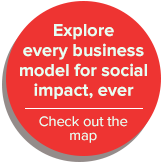 The following post is a transcript of an essay by Matthew Manos originally written in January, 2013 for Forbes Magazine. Note from the author: This is the original blog post that inspired the development of this book, “How to Give Half of Your Work Away For Free”
The following post is a transcript of an essay by Matthew Manos originally written in January, 2013 for Forbes Magazine. Note from the author: This is the original blog post that inspired the development of this book, “How to Give Half of Your Work Away For Free”
The Double-Half Methodology (aka the verynice model) was invented in 2009 as a way to create a viable business strategy that allows for “extreme philanthropy” in small, service-oriented businesses. Put simply, the method is this: Double your work load, give away half for free.
While this model was originally created for a design consultancy, it is in no way limited to designers, and has the capacity to be adopted by dentists, hair stylists, massage therapists, you name it. The following post breaks down the logistics of giving half of your work away for free into five steps in order to transform philanthropy into an accessible—and viable—endeavor for small businesses.
Step 1: Discover and Define What You Can Give, and Who You Can Give To.
I define a social enterprise as a for-profit company that is giving away at least 50 percent of its stuff for free. “Stuff” can hold a broad definition, and it can be one of three things: profits, services, or products. Out of the three, the verynice model focuses specifically on services. Ask yourself: “What can I offer?” If you make logos, the answer to that question is design. If you style hair, the answer is haircuts. After you have defined what you can give, define who you can give to. Non-profits? A specific sector of non-profits? A specific community? The answer to that question will vary depending on the industry your small business is in.
Step 2: Do Twice the Amount of Work You Normally Would.
Though this might sound terrifying, the easiest way to give away half of your work for free while still doing just as well as everyone else is to do twice the amount of work of everyone else. It is quite a comical idea, but it makes sense, right? Let’s say a lawyer typically has five clients at a time. If you multiply that by two, you get 10 clients. Five of those are paid engagements, and the other five are donated. Like magic, you are able to do just as well, while giving away 50 percent of your time to benefit society.
Step 3: Increase Your Bandwidth and Find Support in Creative Ways.
OK, so I’m not crazy. I realize that it’s not easy (or possible) to wake up one morning with twice the amount of work and somehow still expect a good night’s sleep. So how can you increase your bandwidth without going bankrupt? One answer: Build a network of remote team members to join forces with you on your pro-bono endeavors. In the age of iPhones, Google Docs and Skype, remote collaboration has never been easier, but the greatest part of it: it helps keep your monthly overhead tiny. We all have networks of our own that have been acquired organically over time—the people we went to school with, the people we work with, that guy we met at that party. Reach out to members of your network, let them know what you are up to, and invite them to be a part of it. You will be surprised by the enthusiasm your colleagues will have toward collaborating as volunteers for the greater good, especially if you make it convenient to them.
Step 4: Keep Overhead as Low as Possible, Keep Physical Expansion to a Minimum.
Consider working in that coffee shop down the street for a few more months. Are you sure you need that $3,000 chair? Make cuts where possible in your business, and only buy what you really need.
Step 5: Leverage Your Impact, and Use It To Your Advantage.
If the social enterprise movement has shown us only one thing, it is this: Doing well by doing good is not only viable, it is a given. Keep track of your impact and share it with the world. Keep close contact with the people you are donating your services to. Eighty percent of the non-profits verynice has helped over the years are entirely comprised of a volunteer staff that have full-time jobs elsewhere. As a result of building strong relationships with these clients, the majority of our for-profit clientele has actually come to us thanks to a referral from a non-profit organization.
When you are a big business that is making hundreds of millions of dollars each year, handing out a couple million to charity here and there is very easy. But when you are a small business, one that, on average, is making less than $250,000 … well, being philanthropic can be difficult. The verynice model hopes to establish a new standard amongst small business owners in order to define a new kind of corporate philanthropy that has the ability to identify the potential for social good in small business.
